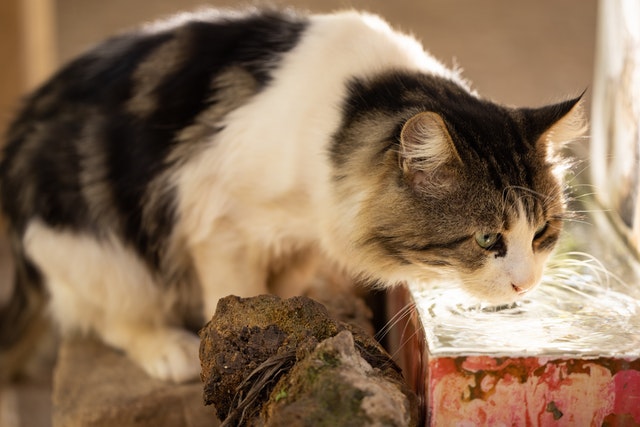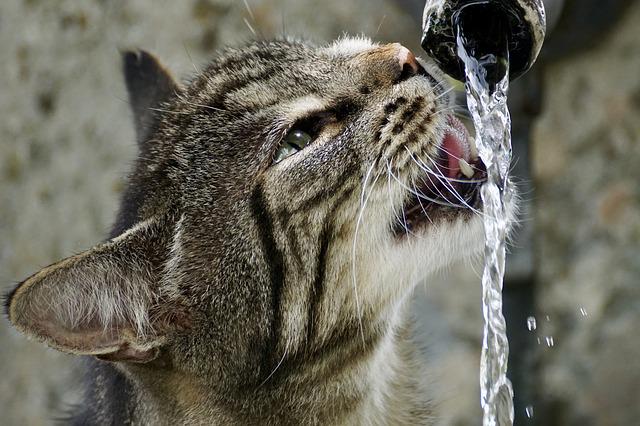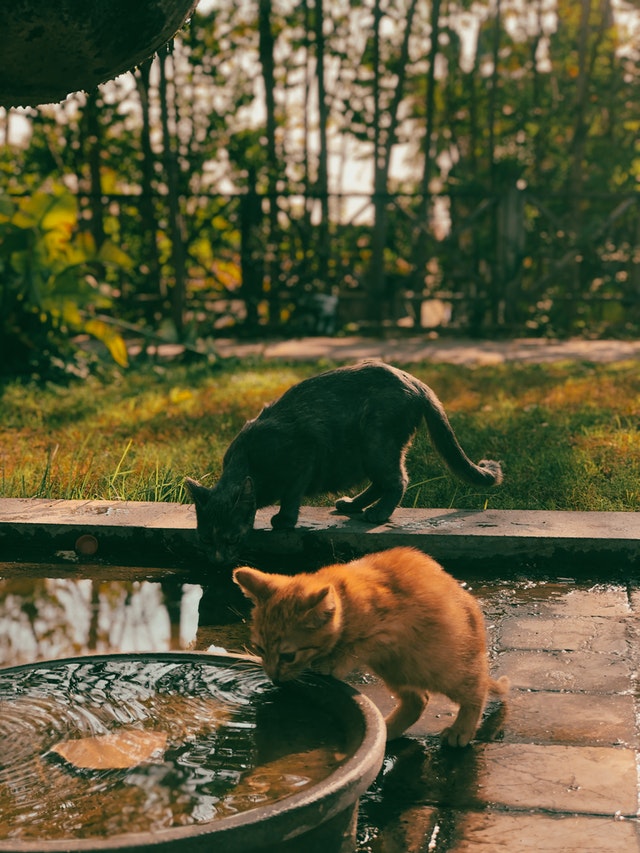How to Get Your Cat to Drink More
Posted: 11/06/2023 | BY: Jenna Bruce | Categories: Uncategorized
Do you have a cat that simply refuses to drink water? This most likely stems from ancient feline history. Did you know our beloved domesticated cats are historically desert animals, coming out of ancient Egypt and the near East? These cats would get most of their hydration needs from their prey, which allowed them to forgo hunting for clean water sources.

While your cat’s ancient ancestors did alright on little water, today’s house cats live much longer lives and therefor require more hydration to stay healthy for longer. For instance, a lack of hydration can lead to kidney disease and bladder stones or crystals. But the more your cat drinks, the more they can flush their urinary tract and keep it healthy and functioning optimally.
But getting some cats to drink more can pose an impossible, hair-pulling task. But don’t worry, we’re going to share some simple but highly-effective tips right now to get your finicky cat to drink more!
Try a Canned Cat Food Diet
If you can’t get your cat to drink more water, get them to eat more water instead. Wet food diets make getting more water into your fur baby much easier. If your cat is currently eating a dry kibble diet, simply add a bit of wet food to it to get them used to it. Most cats are happy to eat some canned food. Increase little by little over time.
If for some reason your cat really does not like the wet food, then try adding a little water or chicken broth to the dry food and let it sit 10-15 minutes before you serve. The kibble will soak up the moisture.
If your cat is currently eating a wet food diet but your vet has encouraged you to increase their water intake even more, then you can simply add a little water or chicken broth into your cat’s food. If your cat refuses to eat the wet food with extra moisture added, don’t try to force them. The last thing you want is for them to develop an aversion to wet food. Simply try another trick from this list.
Water Fountains

Most cats prefer to drink running, rather than still, water. Maybe cats just love a good chase! Whatever the reason, if you haven’t tried it yet, consider getting your cat a water fountain. Another benefit about water fountains is the filter keeps the water nice and fresh. And, if there is no water shortage in your area, you may also want to consider leaving your kitchen or even a bathroom sink on a slow drip.
Try Different Bowls
All cats are different. While many prefer fountains, there are those that won’t go near them. If your cat seems like he or she prefers drinking from a bowl but still isn’t drinking enough, try using different bowls made from different materials. You can try glass bowls, stainless steel and ceramic. Plastic is never a good option. Also experiment with the size and shape of bowls, and also the location of the bowls.
Wash Water Dishes Frequently
Like dogs, cats have an incredible sense of smell, and some cats are sensitive to the smell and taste of water. Be sure to wash your bowls daily to avoid bacterial buildup and refill with cool, clean water.

Fill the Bowl Completely
Cat’s whiskers are incredibly sensitive and many don’t like when their whiskers touch the sides of food and water bowls. For this reason, it’s a good idea to fill the water bowl completely to the top so your cat has an easier time drinking.
Adding Broth or Other Flavoring to the Water
Some cat owners have good results with adding a little chicken, beef broth or tuna juice to the water bowl to entice cats to drink. It’s best to boil your own chicken carcass or beef soup bones in water. Broth you purchase from a grocery store often has too much salt or other ingredients like garlic and onions that can be toxic to cats.
Here’s a tip: Don’t throw leftover broth away. Instead, fill ice-cube trays and freeze. This way you can easily make one batch of broth each month and can simply toss an ice-cube in the bowl as needed.
And speaking of ice-cubes, sometimes just adding regular ol’ ice-cubes to your cat’s water bowl can entice them. First, it keeps the water nice and cold, and most cats seem to prefer cold water. Also, cats like to paw at and play with ice-cubes, and this engagement often leads to a nice slurp and gulp.

Filter Your Water
Cats are very sensitive to the smell and taste of water. The tap water in your area may have a lot of harsh chemicals in it. Try using a filter pitcher or under the sink filtration system for cleaner water. You can also try bottled water, though that isn’t the healthiest option as the chemicals from the plastic leech out into the water.
Again, every cat is different. Some cats will respond to some of these tricks and some to others. Just keep trying until you find something that works for your kitty!
Ensure Your Cat’s Health and Wellbeing with a Comprehensive Insurance Plan
Cat’s make life better. When you love your cat, you want to make sure they are happy and healthy. Sometimes that’s as easy as getting them to drink a bit more water. But sometimes our cat’s health and wellbeing require vet visits. And sometimes, depending on the illness or injury, they can require emergency clinic visits or multiple vet visits with X-rays and medications. And all of this can really add up to a big vet bill!
A pet insurance plan ensures your cat gets the care they need when they need it and also ensures you don’t go into debt trying to give them the very best medical treatment. Depending on the plan and the provider, you may be able to receive reimbursements for up to 90% of the bill.
Pet Insurance Review wants to help pet owners be responsible by finding the best insurance plans on the market. You shouldn’t have to go broke taking care of your fur babies.
Get a free quote today so you can breathe easy.
References:
- Handwerk, B. House Cat Origin Traced to Middle Eastern Wildcat Ancestor, (2007). Retrieved from: https://www.nationalgeographic.com/animals/article/house-cat-origin-traced-to-middle-eastern-wildcat-ancestor
- Carr, J. Kidney Disease in Cats: What Cat Owners Should Know. Retrieved from: https://www.pethealthnetwork.com/cat-health/cat-diseases-conditions-a-z/kidney-disease-in-cats-what-cat-owners-should-know
- Weir, M., DVM, MSc, MPH; Ward, E., DVM. Bladder Stones in Cats. Retrieved from: https://vcahospitals.com/know-your-pet/bladder-stones-in-cats
- Whisker Fatigue in Cats: What it is and How to Help. Retrieved from: https://www.petmd.com/care/whisker-fatigue-cats-what-it-and-how-help
Disclaimer
The information contained on this blog is intended for informational and educational purposes only and should not be construed as medical advice. It is not a substitute for professional veterinary care. Always consult with your veterinarian before making any changes to your pet's health care or treatment plan.
The authors of this blog are not veterinarians and do not claim to be experts in pet health. The information provided here is based on our own experiences and research, as well as information from reputable sources. However, we cannot guarantee the accuracy or completeness of this information.
We encourage you to do your own research and consult with your veterinarian before making any decisions about your pet's health.
Previous post
Hairball Prevention in Cats: Try These RemediesCompare top pet insurance providers plans.
Enter your dog’s age in years and months to calculate their age equivalent to human years.
Calculate your dog’s ageEnter your cat’s age in years and months to calculate their age equivalent to human years.
Calculate your cat’s age